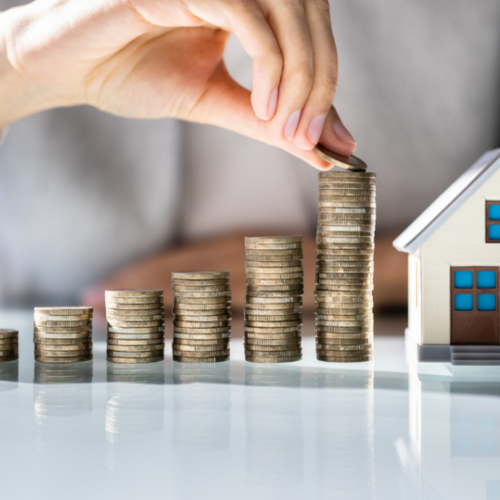Selling your first home is a major milestone, filled with both excitement and uncertainty. Whether you’re moving to a bigger house, relocating for work, or simply ready for a change, selling a home is a significant financial transaction. You want to get the highest possible price, but the process can feel overwhelming, especially if you’re unfamiliar with how home sales work. Pricing, staging, negotiating—there’s a lot to think about, and making the wrong move could cost you thousands of dollars.
Luckily, you don’t have to figure it all out alone. By following the right steps, you can attract the right buyers, sell quickly, and maximize your home’s value. Whether your goal is to sell as fast as possible or to secure the best price, a well-planned strategy will help you achieve it. In this guide, we’ll walk you through seven essential steps to selling your first home for top dollar.
Step 1: Understand Your Home’s Value
One of the biggest mistakes first-time home sellers make is mispricing their home. If you price it too high, you risk scaring off potential buyers, leaving your home sitting on the market for months. If you price it too low, you could lose money that you would have otherwise earned. Understanding your home’s market value is key to setting the right price and maximizing your profit.
Your home’s value is based on multiple factors, including its location, size, condition, and recent market trends. Homes in desirable neighborhoods—close to schools, parks, and shopping centers—often sell for higher prices. Similarly, updated homes with modern features tend to attract more buyers. Additionally, if the real estate market is hot and homes are selling quickly, you might be able to list your home at a higher price than in a slow market.
How to Find Your Home’s Value
There are several ways to determine your home’s value:
- Look at Online Estimates – Websites like Zillow, Redfin, and Realtor.com provide quick home value estimates based on public records. While they can be helpful, they aren’t always accurate, so don’t rely solely on them.
- Compare Recent Home Sales in Your Area – Check the selling price of homes similar to yours that have recently sold in your neighborhood. This will give you an idea of what buyers are willing to pay.
- Work With a Real Estate Agent – A real estate professional can conduct a Comparative Market Analysis (CMA), which compares your home to similar properties to determine a fair and competitive price.
- Hire a Professional Appraiser – If you want the most precise valuation, consider paying for a professional appraisal. An appraiser will assess your home’s condition, location, and recent sales data to provide an unbiased valuation.
Taking the time to understand your home’s value will help you set a price that attracts serious buyers without leaving money on the table.
Step 2: Choose the Best Time to Sell
Timing is one of the most important factors when selling a home. If you list your home at the right time, you could attract more buyers, receive multiple offers, and sell for a higher price. But if you choose the wrong time, your home could sit on the market longer than expected, forcing you to lower your price to attract interest.
The best time to sell varies depending on market conditions, seasonality, and your personal situation. Generally, some months are better than others for selling a home, but that doesn’t mean you can’t sell at other times. Understanding the real estate cycle can help you make a more informed decision.
Best Seasons for Selling
- Spring and Summer – These are the best times to sell a home. The weather is warm, families prefer moving during summer, and buyers are actively searching. Homes tend to sell faster and at higher prices in these months.
- Fall – While demand slows down slightly, serious buyers are still in the market. If you need to sell in the fall, focus on staging and pricing your home competitively.
- Winter – This is typically the slowest time for home sales, as fewer people are looking to move during the holidays. However, since there is less competition, well-priced homes can still sell quickly to motivated buyers.
If you can plan ahead, try to list your home in spring or summer. But if life circumstances require you to sell in a different season, strategic marketing and staging can help you get the best possible price.
Step 3: Make Smart Improvements
Many home sellers wonder whether they should invest in home improvements before selling. While some renovations can increase your home’s value, others may not be worth the cost. The key is knowing which updates will give you the biggest return on investment.
Small, inexpensive improvements can make your home look more appealing to buyers and help it stand out from the competition. You don’t need to remodel your entire kitchen or add a new bathroom, but a few smart upgrades can make a big difference.
High-Value Home Improvements
- Fresh Paint – A new coat of paint, especially in neutral colors, makes a home look clean and modern.
- New Light Fixtures – Outdated lighting can make a home feel old. Upgrading to modern, energy-efficient fixtures adds style and brightness.
- Updated Hardware – Replacing cabinet handles, faucets, and doorknobs is a small upgrade that adds a fresh touch.
- Curb Appeal Enhancements – First impressions matter! Trim the lawn, plant flowers, and paint the front door to boost your home’s exterior appeal.
- Deep Cleaning – A spotless home looks well cared for and can make a big impact on buyers.
The goal is to make your home feel move-in ready so buyers can picture themselves living there. Avoid major renovations unless absolutely necessary—focus on small changes that create a big impact.
Step 4: Stage Your Home Like a Pro
The way your home looks when buyers walk through the door can make or break a sale. Staging is the process of arranging furniture, décor, and lighting to make your home look more appealing. It helps buyers envision themselves living there, which can lead to higher offers.
A well-staged home creates an emotional connection with buyers. It highlights your home’s best features, makes rooms feel larger, and creates a welcoming atmosphere. Even small changes—like rearranging furniture, adding fresh flowers, or adjusting lighting—can make a big difference.
Easy Staging Tips
- Declutter Every Room – Remove excess furniture and personal items to make the space feel larger and open.
- Use Neutral Colors – Bright colors might turn buyers away, so stick to soft, neutral tones.
- Let in Natural Light – Open curtains, clean windows, and use mirrors to make spaces feel brighter.
- Add Cozy Touches – Fresh flowers, decorative pillows, and stylish rugs make rooms more inviting.
- Depersonalize – Remove family photos and personal items so buyers can imagine themselves living there.
A well-staged home stands out in online listings, attracts more buyers, and often sells for a higher price.
Step 5: Market Your Home Like a Pro
Once your home is in great shape and ready to sell, the next step is making sure buyers know about it. Marketing is one of the most important parts of the selling process because the more people who see your home, the more offers you’re likely to get. If buyers don’t know your home is for sale or aren’t impressed by the listing, you might struggle to attract interest.
Many first-time sellers think that simply putting up a “For Sale” sign and listing their home online is enough. But today’s real estate market is highly competitive, and you need a strong marketing strategy to stand out. Professional photos, a compelling listing description, and strategic online exposure can bring in more buyers and increase the chances of multiple offers—which means more money in your pocket!
Ways to Market Your Home
- Hire a Professional Photographer – High-quality photos are essential! Most buyers start their search online, and homes with bright, well-lit photos get far more attention than those with dark, blurry images.
- Create a Virtual Tour – Many buyers want to see a home from the comfort of their couch before visiting in person. A 3D virtual tour helps them explore your home online.
- Write a Compelling Listing Description – Your listing should highlight your home’s best features, including upgrades, layout, and neighborhood benefits. Use descriptive and inviting language to draw buyers in.
- Leverage Social Media – Share your home listing on Facebook, Instagram, and local real estate groups to reach more potential buyers.
- Hold Open Houses and Private Showings – Open houses can bring in multiple buyers at once, while private showings allow for personalized tours.
- Work with a Real Estate Agent – Agents have access to the MLS (Multiple Listing Service) and marketing tools that expose your home to a wider audience.
A well-marketed home gets more attention, attracts more buyers, and often sells faster and for a higher price.
Step 6: Be Smart About Pricing and Offers
Once your home is on the market and buyers start showing interest, you’ll begin receiving offers. This is an exciting stage, but it’s also where many first-time sellers make mistakes. You don’t want to rush into accepting the first offer that comes your way—there might be better offers coming soon! However, waiting too long or negotiating too aggressively could scare buyers away.
It’s important to look at more than just the price when reviewing offers. You also need to consider the buyer’s financial situation, contingencies, and closing timeline. A high offer might not be the best one if the buyer doesn’t have strong financing or is asking for too many conditions.
Handling Offers Wisely
- Don’t Accept the First Offer Too Quickly – If you get an offer right away, don’t rush to accept it unless it’s exactly what you wanted. Other buyers may be interested, and you could end up with a better deal.
- Look Beyond Just the Price – Consider whether the buyer is pre-approved for a loan, how quickly they can close, and any contingencies they’ve included (such as a home inspection or financing approval).
- Be Ready to Negotiate – Buyers often ask for small repairs, closing cost help, or minor price reductions. Be flexible but firm when negotiating so you don’t lose out on a good offer.
- Review Multiple Offers Carefully – If you receive more than one offer, compare them carefully. A slightly lower offer from a strong, pre-approved buyer might be better than a higher offer from someone with financing uncertainty.
Your real estate agent can help you evaluate offers and negotiate effectively so you get the best possible deal.
Step 7: Get Ready for Closing Day
Once you’ve accepted an offer, you’re in the final stretch of the selling process! However, there are still a few important steps to take before you hand over the keys. Closing involves inspections, paperwork, and final financial transactions, so staying organized will help avoid last-minute delays.
Many first-time sellers assume that once the offer is accepted, the hard work is done. But unexpected issues can pop up—such as appraisal problems, buyer financing delays, or repair requests. Being proactive and working closely with your agent will help ensure a smooth closing process.
What Happens Before Closing?
- The Home Inspection – Most buyers will order a home inspection to check for any hidden issues. If problems are found, they may ask for repairs or request a price reduction. Be prepared to negotiate.
- The Home Appraisal – If the buyer is financing the purchase with a mortgage, the lender will require an appraisal to confirm that the home’s value matches the purchase price. If the appraisal comes in lower than expected, negotiations may be needed.
- Final Walkthrough – Before closing, the buyer will do a final walkthrough to ensure the home is in the expected condition. Make sure the home is clean and any agreed-upon repairs have been completed.
- Signing the Closing Documents – You’ll need to review and sign various legal documents to officially transfer ownership of the home. Your agent and the title company will guide you through this process.
- Moving Out – Plan your move ahead of time so you’re fully out of the home before closing day. If you need extra time, negotiate a rent-back agreement with the buyer.
Avoid Closing Delays
- Complete Any Agreed-Upon Repairs Promptly
- Stay in Communication with Your Agent and the Buyer’s Lender
- Have All Required Paperwork Ready
Once everything is signed and finalized, you’ll receive your sale proceeds, hand over the keys, and officially sell your home!
Final Thoughts: Maximize Your Home Sale with These 7 Steps
Selling your first home may seem overwhelming, but with the right strategy and preparation, you can sell quickly and for top dollar. By following these seven steps, you’ll attract the right buyers, negotiate smartly, and walk away with the best possible sale price:
- Understand Your Home’s Value – Set the right price to attract buyers and avoid costly mistakes.
- Choose the Best Time to Sell – List your home when demand is high to maximize your price.
- Make Smart Improvements – Small upgrades and repairs increase your home’s value.
- Stage Your Home Like a Pro – A well-presented home sells faster and for more money.
- Market Your Home Effectively – High-quality photos, online exposure, and open houses bring in more buyers.
- Be Smart About Pricing and Offers – Evaluate offers carefully and negotiate to get the best deal.
- Get Ready for Closing Day – Stay organized to ensure a smooth transaction.
By taking these steps, you’ll increase your home’s appeal, attract more offers, and maximize your final sale price. Whether you’re selling now or planning to sell in the future, these strategies will help you navigate the home-selling process with confidence.
Are you ready to sell your home? Reach out to a trusted real estate professional today to start the process and maximize your home’s value!




